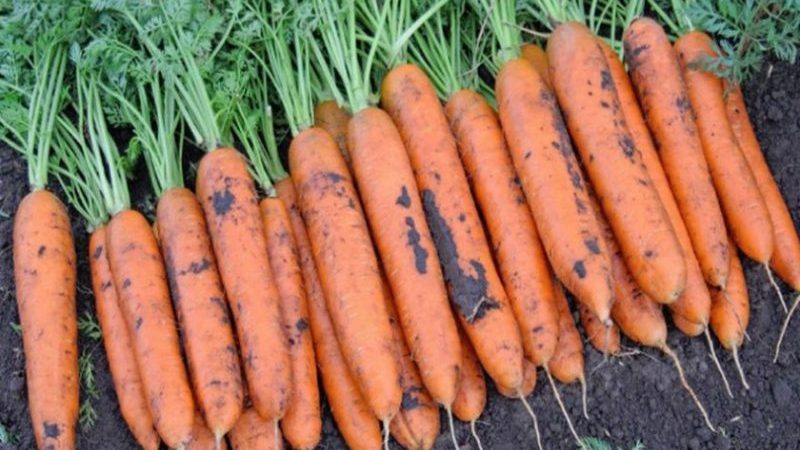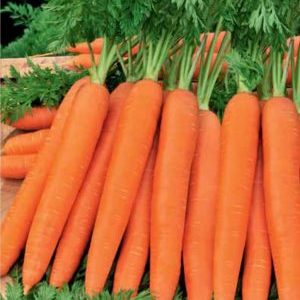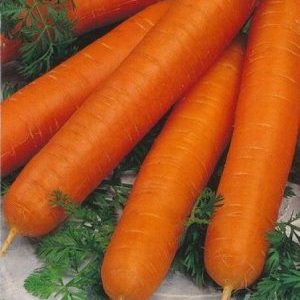High-yielding Romos carrot with strong immunity
Romosa is a mid-season carrot variety characterized by a high yield and strong immunity. Forms even and smooth roots with a slightly pointed tip. Compliance with the basic rules of agricultural technology for vegetable crops is the key to a rich and tasty harvest.
The content of the article
Description of the Romos carrot variety
The Romos variety is a representative of the Berlikom variety. Popular due to its high yield and resistance to major diseases of the umbrella family. Regardless of the type of soil, up to 65 tons of carrots can be harvested from 1 ha.
Large root crops with a rich orange color have a pointed tip. They are easily pulled out of the soil, so the risk of damage during harvesting is significantly reduced.
Carrots are preserved without loss of shape and taste for 8 months.

Origin and development
Romos is an achievement of Dutch breeders from Bejo Zaden B.V. The work of specialists was aimed at breeding not only a vegetable crop that is high-yielding and resistant to diseases and pests, but also has a remarkable taste characteristics.
Reference. Romosa belongs to the best professional varieties of well-known foreign seed producers, recognized as leaders in world breeding.
Chemical composition, trace elements and vitamins, useful properties
Romos carrots are low in calories. 100 g of raw product contains only 35 kcal (88% of the weight is water).
Due to the richest chemical composition, the orange vegetable brings many-sided benefits to the human body. It is rich in vitamins (A, E, C, PP, H, K, group B) and minerals (potassium, chlorine, phosphorus, calcium, magnesium, sulfur and others).
The benefits of eating Romos carrots:
- cleansing the blood;
- normalization of metabolic processes;
- strengthening the immune system;
- improvement of vision;
- removal of stones and sand and kidneys;
- cleansing the liver;
- vasodilation, a beneficial effect on the work of the cardiovascular system;
- normalization of digestion, solving the problem of constipation;
- used to treat angina when used in conjunction with honey;
- relieves inflammatory processes in the oral cavity (stomatitis, gingivitis).
Ripening period
The variety is characterized by an average ripening period. From the moment of emergence to harvest, it takes from 120 to 127 days.
Yield
Romosa has a high yield... From 1 m² you can harvest 4–6.5 kg of large root crops of the same size. The marketability indicator is 97%.
The variety is grown on an industrial scale. At the same time, up to 47 t / ha are harvested from the field.
Reference. The maximum yield of Romos carrots was obtained in the Vladimir region. There, 59 t / ha were collected from industrial fields.
Disease resistance
The variety has strong immunity.With proper care, a vegetable crop is resistant to diseases, in particular fungal infections.
Characteristics, description of appearance, taste
The Romos carrots growing in the beds are characterized by a semi-spreading rosette with green leaves that have an average degree of dissection. The variety has strong, upright leaves. This makes harvesting easier.
Marketable appearance is inherent in root crops. They differ:
- cylindrical, pointed towards the tip;
- smooth surface of bright orange color, not prone to cracking;
- orange juicy and sweet pulp;
- large dimensions (length 25 cm, diameter 3 cm);
- weighing from 100 to 200 g.
Carrots are eaten fresh. They are used for making juices, mashed potatoes, soups, salads, vegetable stews and other culinary masterpieces.
For which regions it is best suited and what is the exacting climate
Romosa is in the Russian state register of vegetable crops. Experts recommend a variety for cultivation in the regions:
- Central;
- Volgo-Vyatsky;
- Nizhnevolzhsky;
- Uralsky;
- Far East.
The plant is not demanding on climatic conditions. It perfectly tolerates heat and frost down to -3 ° C.
Main advantages and disadvantages of the variety
Romos carrots have no significant disadvantages other than the need for additional protection against fungus during rainy summers.
The advantages include:
- unpretentiousness to climatic conditions and care;
- high productivity;
- resistance to cracking and damage;
- attractive appearance and sweet taste;
- ease of harvesting;
- resistance to diseases and pests;
- good keeping quality without loss of marketability and taste.
What is the difference from others
Difference from other varieties of carrots, except for high yield:
- an increased content of beta-carotene - in 100 g of root crops 18.5 mg of a substance (the average for a vegetable crop is 12 mg);
- a higher percentage of sugars (8.1%), providing a sweet taste to the fruit.
Table. Comparison of popular varieties of carrots in terms of yield
| Name | Ripening period | Productivity, kg / m2 | Root weight, g | Carrot length, cm |
| Romos | mid-season | 6,5 | 100-200 | 25 |
| Vita longa | mid-season | 5 | 150-300 | 20-24 |
| Dayana | mid-season | 4,5 | 110-180 | 12-15 |
| Topaz | medium early | 4 | 100 | 13–15 |
| Cascade | late | 3,9 | 110–200 | 8–12 |
| Malika | mid-late | 4,5 | 60–90 | 10–14 |
Features of planting and growing
To get a rich harvest, adhere to the basic rules of carrot farming. Violation of them threatens weakening of crops, vulnerability of seedlings to diseases and pests.
Preparing for landing
A well-lit area is better suited for planting Romos. Carrots don't like shade.
The preparatory stage for sowing seed includes:
- cleaning the soil from weeds;
- soil enrichment with nitrogen, phosphorus and potash fertilizers;
- deep digging up to 30 cm deep.
Important. Seeds of the Romos variety do not need soaking and germination. Branded seed material is treated with fungicides.
Ground requirements
The soil for planting should be:
- loose and fertile;
- sandy loam or light loamy;
- with low acidity;
- well aerated;
- without stagnant water.
Predecessors
The best predecessors are: tomatoes, cucumbers, potatoes, onions, legumes. It is not advisable to plant where carrots, beets, turnips, dill and parsley previously grew.
Timing, scheme and landing rules
Seed material is sown on ridges or ridges. This happens in the last days of April - early May. The seeding depth of the seed is 1.5-2 cm. The distance between the rows is 20 cm. The seeds are planted keeping a distance between them in a row of 5-7 cm. The planting depth is 2 cm.
Subwinter sowing is carried out in the last days of October - early November, when the temperature reaches + 5 ° C
Sowing takes place as follows:
- Furrows are made of the required length and depth, observing the distance between them.
- The depressions are sprinkled with sand.
- Furrows are watered.
- After the moisture has been absorbed, the seeds are laid out with the required distance.
- The planting is covered with soil, slightly compacting it.
Growing features
In spring, cover the bed with peat (1 cm). In the fall, a layer of mulch (2-3 cm) is required.
The nuances of care
Caring measures include:
- thinning;
- watering;
- fertilizer.
The variety does not require additional care.
Watering mode
The Romos carrot variety does not need frequent watering. In a dry season, the garden is watered more often. The water should be warm, settled.
On average, young seedlings are watered once every 7 days with 5 liters of water per 1 m², and adult plants - once every 14 days for 6-8 liters.
The last watering is 14 days before harvest (2 buckets per 1 m²).
Thinning and weed control
Weeding is carried out as needed so that weeds do not drown out the growth of carrots.
Thinning is necessary if the seeds have been sown too thickly. When the seedlings have 2 leaves, the first thinning is performed, removing weak seedlings and keeping the distance between the plants 2-3 cm.When the last thinning, 5-7 cm are left between the root crops.
Top dressing
After 20-25 days after the emergence of seedlings, nitrogen fertilizers are applied, and after 15-20 days - phosphorus-potassium fertilizers.
Reference. It is impossible to overfeed with nitrogen fertilizers, so as not to slow down the development of the root crop.
Carrots don't like organic matter.
Disease and pest control
The Romos variety is resistant to diseases and pests. However, violation of the rules of agricultural agricultural technology provokes a number of problems.
Attention. As a preventive measure, it is permissible to treat carrots with fungicides. But do this no later than 30 days before harvest.
The main enemy of carrots is the carrot fly. To combat it, toxic chemicals "Intavir", "Actellik" and others are applicable.
Most often, problems appear due to alternaria or phomosis. Treatment of the planting with a solution of Bordeaux liquid (concentration 1%) will help reduce the risk of developing diseases.
Harvesting and storage
Timely harvesting and proper preparation for storage ensure long-term keeping quality without losing its presentation.
How and when to collect
Selective harvesting of ripe root crops can be carried out as early as July. The main harvesting takes place in late August and September, in dry weather.
Storage features and keeping quality
The vegetable is stored for 8 to 10 months. Keeping quality is above 90%.
Store carrots in wooden boxes with sand. The temperature regime in the cellar should not be higher than + 2 ° С, humidity - 85-95%.
What can be the difficulties in growing
Due to a violation of the cultivation technology, the variety can be affected by fungal diseases. Fungal infection occurs with potassium deficiency. It is also provoked by cold, damp weather. Sick vegetables are destroyed so that they do not contaminate the soil.
Sometimes the roots are deformed... The problem is provoked by the introduction of fresh manure, drought, heavy rocky soil.
Planting carrots can be attacked by a carrot fly, which is difficult to control. Pesticides have a weak effect on the pest.
Reference. Most often, the carrot fly affects the varieties Nantes, Carotel, Chanson.
Tips from experienced gardeners
Experienced gardeners recommend:
- sow seeds into grooves where urea and superphosphate granules are decomposed;
- carry out deep plowing in the fall, and in the spring, loosen the soil to a depth of 3 cm - this will improve germination;
- plant garlic or onions next to the carrot bed to scare off the carrot fly.
Reviews of the Variety of carrots Romos
Reviews of the Romos Variety are mostly positive.
Marina, Rostov-on-Don: “I have been growing the Romos carrot variety on my site for several years now. I am always happy with the harvest. When planting seeds, I make holes for carrots, sprinkle the grooves with sand, water well and plant the seed. The sowing is not thick so that you do not have to thin out. Seed germination is good. The plant itself is unpretentious in care. However, at the first stage of growth, it needs abundant watering. "
Anton, Tver: “I liked the Romos variety.Now I plant only him. The carrots are long and have a sweet taste. To make it more sweet, I feed the planting with potassium and magnesium. The main thing is not to make organic fertilizers. Then the root vegetable grows pale and savory. "
Read also:
Can you be allergic to carrots?
Conclusion
Romos carrots are an excellent choice for a summer cottage. To get a crop that has excellent marketability and taste, it is enough to adhere to the basic rules of agricultural culture.
The variety successfully resists the main diseases of the crop, forms smooth fusiform and long fruits of a presentation. Romos is suitable for both personal cultivation and commercial use.